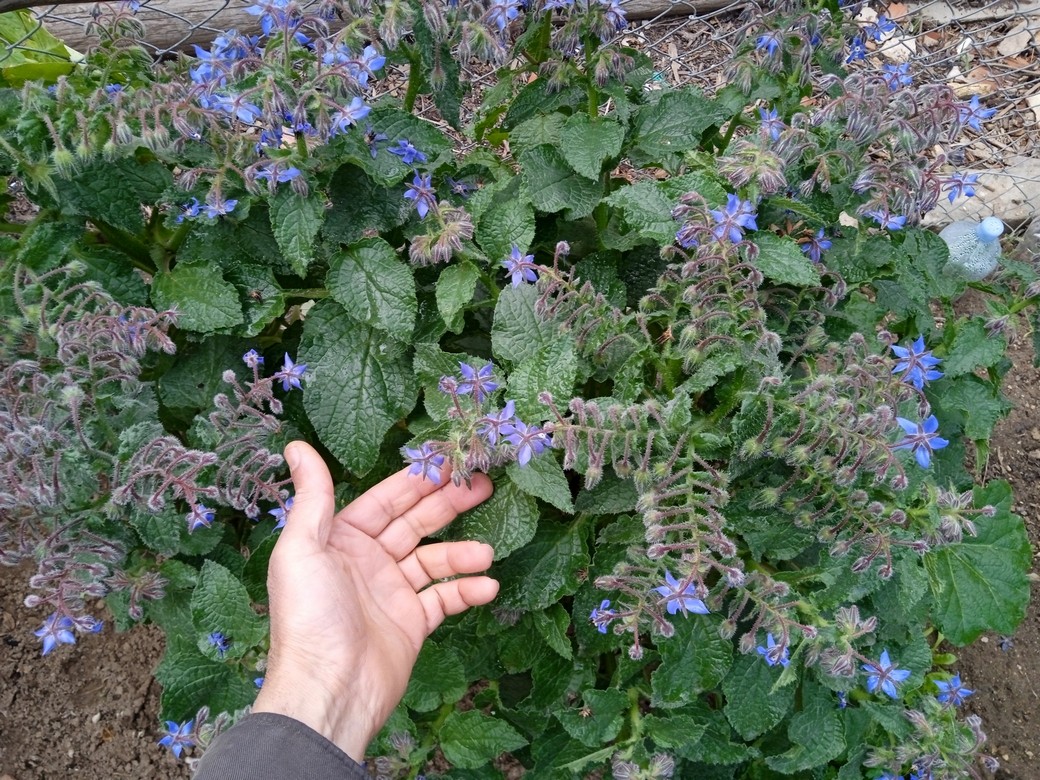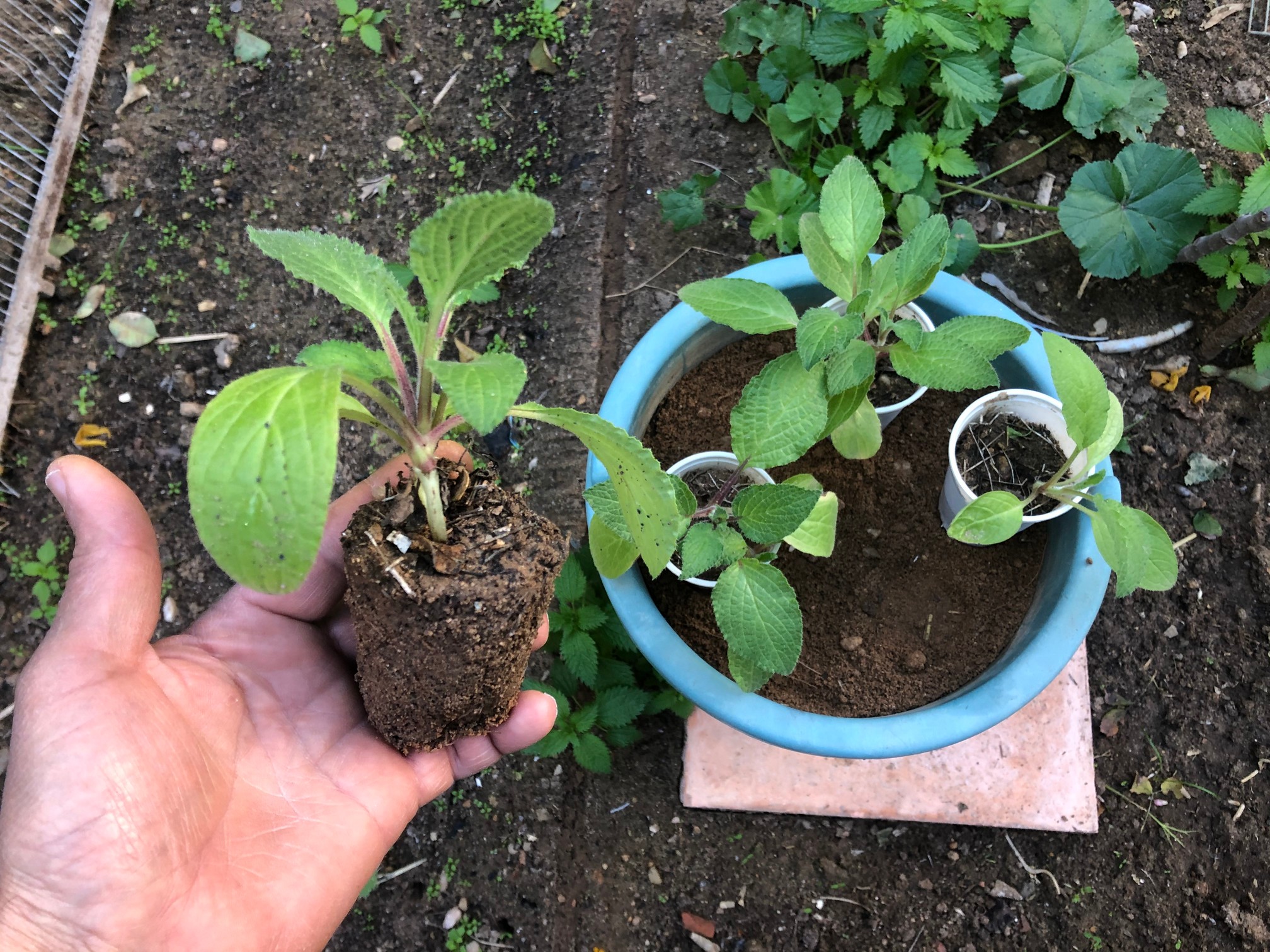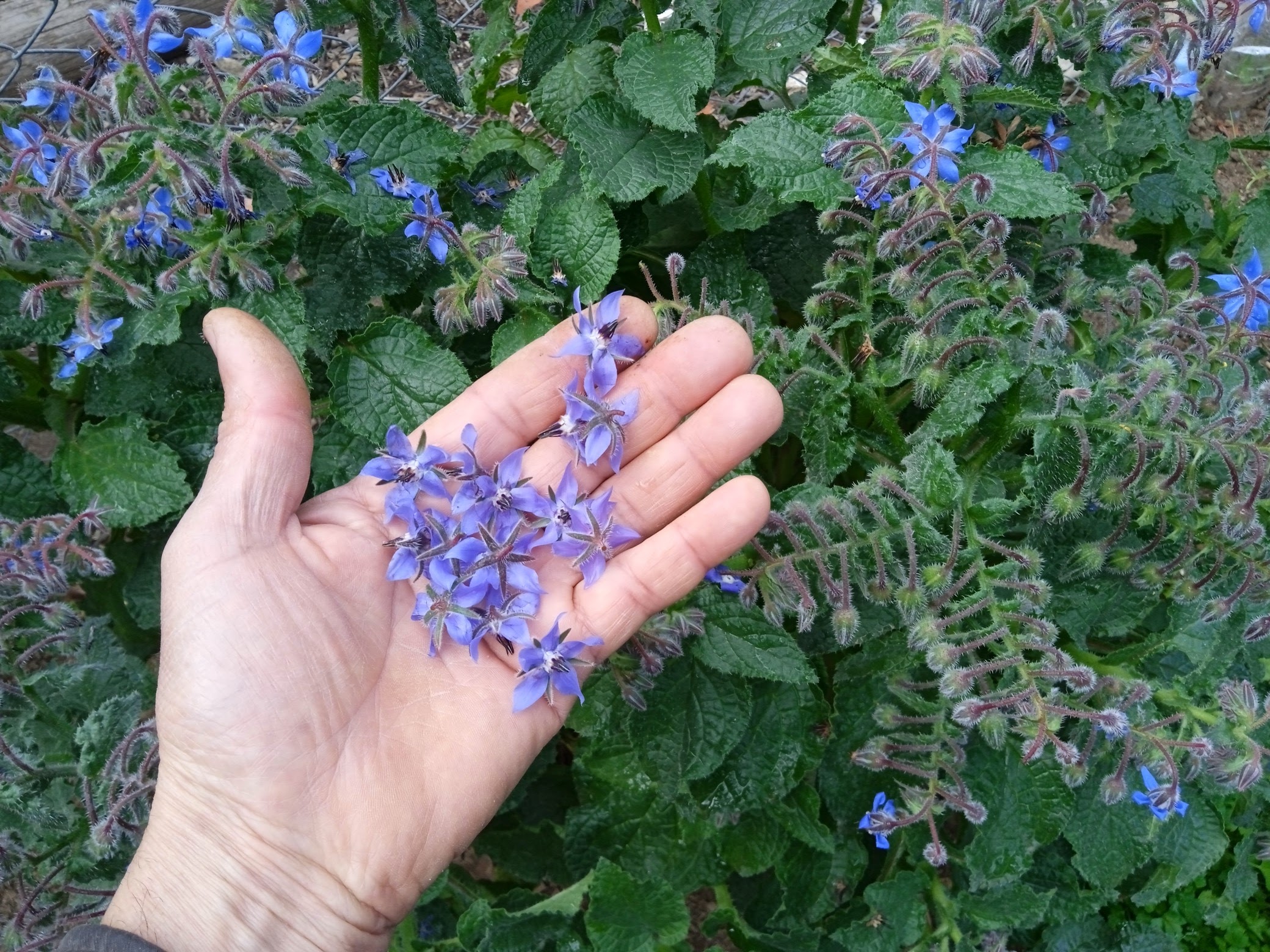Borage is Mediterranean native herb also called starflower, and bee bread. It is used in medicinal purposes as well as many garden uses. Growing borage (Borago officinalis) in pots or containers is so easy and it is a powerful herb for healing and companion planting, and growing borage adds a touch of beauty to your garden. Not only is borage a beautiful addition to your garden it has some benefits too. Borage is an excellent companion plant. This plant will attract bees as well as other beneficial bugs, and provides a valuable source of nectar for them. As gardeners we know how much important pollinators are to our garden. Borage is also known to repel tomato worms and cabbage moths as well, and when planted near your squash it can improve their flavor. Borage has a strong fragrance and repels most insects that might eat it. This aromatic plant is also rich in nutrients like calcium and potassium, that's why borage is so useful and a must have plant in our gardens for all it's benefits!
{tocify} $title={Table of Contents}
Borage takes about 8 weeks to mature, and begin producing flowers, so you can harvest the leaves and flowers as needed.
This is a Step by Step Guide to Growing Borage in Pots or Containers
You must know before you get started that once you plant borage in your garden, you will have it for ever. This annual plant will self-seed itself and pop up every year in your garden. I don't consider borage invasive because it's far too beneficial to become problematic, and the best of all is that when a plant pops up that you don’t want it, it’s simple to pull and either eat or add to your compost pile. That's why i think borage is a must have plant in our gardens.
Borage Varieties to Grow
Common borage (Borago officinalis) – Also known as starflower, common borage is the most familiar of the different types of borage. The bright blue flowers are star-shaped. The fresh plant has a salty flavor and a cucumber-like odor. Plants average 18-24″ tall and produce loads of small, edible flowers that are light blue. Works great when grown in containers, raised beds or in-ground gardens. It can also be used as a warm-season cover crop to provide ground cover and feed pollinators.
Borago officinalis 'Alba' is an annual plant in the Boraginaceae family. This rarely grown variety is native to the Mediterranean region and has naturalized in many other locales such as Europe, Denmark, France, Germany, and the United Kingdom. It grows to heights of 3 feet tall and 2 feet wide. It grows well in full sun with rich, well-drained soils. It will bloom from Summer to fall in pure white.
$ads={1}
Borago Officinalis 'Bianca' - Grow this decorative plant from Borage seeds. Borage herb seeds produce these beautiful star-shaped white flowers and textured leaves. Borage herb benefits include beauty in the garden, attraction for bees and a great addition to summer drinks. Borage Bianca is compact, later flowering and sturdier than standard borage. Excellent in pots. Plant this unusual 24 inch annual herb for its pure ornamental value, to attract much-coveted bees to your garden, and to harvest for teas and other summer drinks. When young, the cucumber flavored leaves may be added to salads.
Growing Borage in Pots or Containers
When to Plant Borage
You can plant borage seeds in pots or containers in early spring after the threat of frost has passed. Or you can start seeds indoors three to four weeks before your area's projected last frost, and transplant seedlings into containers once the soil has warmed, making sure to harden them off first (gradually acclimate them to outdoor conditions) Keep in mind borage plant reaches heights about 3 feet (1 m) and have long and sturdy taproot . Therefore, potted borage plants need a sturdy pot with a depth and width of at least 12 inches (31 cm)
Site Selection
Select a spot for your pots that gets at least six hours of direct sunlight on most days. Better, growing borage plants in full sun will give you the best chance at a plant with lots of blooms!
Planting Seeds in Pots
Direct-sow borage seeds in pots after the last frost has passed.
Choose pots with a depth and width of at least 12 inches (31 cm) of any shape, and fill with qood quality potting mix
Plant seeds 1/4 to 1/2 inch deep, and cover them with a light layer of the potting mix.
Spray with water to moisten the top layer so water reaches the seeds.
Position the containers in full sun.
Always, ensure the potting mix is moist till the plants are well established.
After ten days you’ll see the new plants pushing through the soil.
Thin out to one plant every 15 inches once they are 2 inches tall.
Once germinated, borage seedlings are easy to care for. Regularly weeding around the plants will help to ensure that they can access as much moisture as they need.
In spring feed with an all-purpose organic liquid fertilizer.
Transplanting Seedlings in Containers
It’s easiest to sow borage seeds directly into the garden in a full sun location, but you can start borage indoors if you want. Starting borage indoors will give your plants a headstart and means they will bloom more quickly when the growing season starts.
In order to give your new borage seedlings the best chance of success it is best to ‘harden them off’ prior to leaving them outside in the garden full time. About 7 days before planting your plants outdoors, help acclimate them to temperatures, sunlight, and wind. This is the process of hardening off, or gradually acclimating you new plants to outdoor conditions.These plants have spent their short lives in a warm, sunny, protected place and won't fare well if you don't expose them slowly to the elements. Hardening off’ is the vital process of getting your seedlings ready for transplanting outdoors. Just follow these simple instructions in order to give your plants the best chance of success!
Borage is resilient enough that you don’t have to worry too much as long as you take a little care when transplanting. You can transplant them into pots or containers when they are six to eight inches tall, and all danger of frost has passed.
Soil Preparation for Growing Borage in pots or Containers
A little preparation will ensure better results for growing borage in pots or in containers. The ideal soil for this herb is loose and moist, but well-draining. Borage need nutrient-rich soil with a pH between 6.5 and 7.5 is best. Soils that are too firm need to be loosened up before planting and possibly enriched with sand or potting compost. The soil in the pots doesn't have to be improved with organic matter but, if you do, it will certainly help your plants to grow bigger. You can add composted chicken manure. This composted manure provides a slow-release source of macro- and micronutrients and acts as a soil amendment. Your borage plant will grow bigger, and you will enjoy harvesting leaves and flowers all summer long!
Planting Borage Seedlings
Remove each seedlings from its pot by turning it upside down and tapping lightly on the bottom, it will slide out easily. This should be done with great care not to damage the delicate root system.
Gently run your fingers through the roots to loosen them a little.
Use a hand trowel to dig a hole about twice the size of the rootball.
Place the plant into that hole so that your plant is positioned upright.
Cover the roots of your plant with soil to secure your plant in place.
Press the soil firmly around the roots to ensure good soil-to-root contact.
You can plant seedlings every 10 inches.
Caring for Pots or Containers Grown Borage
Watering Borage Plants
Water borage seedlings regularly until they are established. Once the plants are established and growing well, allow the soil to dry out between waterings. Always remember plants growing in containers will require more frequent watering than those in the ground.
Water borage plants deeply whenever the top 1 to 2 inches (2.5-5 cm.) of potting media feels dry to the touch, then let the pot drain. Check often during hot, dry weather, as plants grown in containers dry quickly, but be careful not to let the soil become soggy, which promotes rot, and you will loose your plants.
Borage Plants Fertilization
When growing borage in containers generally there's no need for fertilizer. If you decide to feed the plant, use a diluted solution of a water-soluble fertilizer. Avoid overfeeding, which often promotes lush foliage but few blooms.
Mulching
Place organic mulch around the base of the borage plants to helps the soil to retain soil moisture. As the mulch breaks down it also enriches the soil, further benefiting the borage plants. Mulching also helps to keep the borage foliage off the soil. When contacting soil, particularly damp soil, foliage can rot or become diseased.
How to Prune Borage?
Pruning helps the Borage plant grow faster and stays upright. Prun th plant in summer to keep it tidy. Deadhead if you want to keep the blooms coming and prevent self-seeding. Prune or pinch out new growth once the borage reaches about 6 inches in height. This encourages branching and helps to keep the plants more compact and robust. in midsummer prun back the plant to half size to encourage the Borage plant to produce new fresh, and tender leaves for a late harvest.
Harvesting Borage
When borage starts flowering, you can harvest frequently to encourage more bloom-production. The leaves and the flowers of borage are edible with a flavor like a cucumber. As the stalks and leaves are covered with fine, silvery hairs that tend to get pricklier as they mature . It’s wise to handle the plant with gloves while picking borage leaves. When picking borage leaves, select the young ones, which will have less of the little hairs. Just take a scissor and snip right below a cluster of blossoms.
Borage Uses
Borage has a long history of medicinal and culinary uses that dates back over 1,500 years. This plant is cultivated and widely used in Europe for its healing properties. Borage is packed with many healthy nutrients that are great for the body. It's a good herbal supplement for women because it contains high levels of calcium and iron, nutrients many women are deficient in. Potassium, Zinc, vitamins B and C, and beta carotene are packed into the borage plant making it very nutritional. As a common herbal treatment in traditional medicine practices for centuries, borage oil has a multitude of uses that range from supporting optimal brain functioning to relieving pain and treating skin conditions.
$ads={2}
Borage is a nice addition to salads, soups and sauces. Borage flowers are edible, and are often candied as a cake decoration. Fresh blooms and small leaves of borage can be used in a salad, and large leaves are very good in soups or cooked like spinash.
Borage is an excellent companion plant.
This flowering herb with blue star-shaped blossoms, is my favorite of pollinators in general. Borage plant will attract bees as well as other beneficial bugs, and provides a valuable source of nectar for them. As gardeners we know how much important pollinators are to our garden!
Harvesting Borage Seeds
When the pods ripen and turn brown you can harvest the seeds . Keep in mind, if the seed heads aren’t removed they will split and the plant will re-seed it self in the same position the next following year. Allowing the plant to re-seed it self, can also cause it to spread through the space they occupy. Unwanted plants are easily pulled up.
Storing Borage Seeds
Store seeds in a cool, dry location, such as an airtight tin, until next time you want to sow. Remember to label your seeds with the date as well as the name of the seeds. This helps you to remember what seeds you have as well as gauging their viability.
Preserving and Storing Borage
You can dry the flowers and leaves in the microwave by putting them in a single layer on paper towels and microwaving them for one to three minutes.
The Flowers and young leaves can get frozen and put into ice cubes. Simply put your borage flowers, and leaves in a plastic bag to freeze them. You can add them to your favorite drinks oto add a splash of colors.
You can safely refrigerate the stems and leaves of your borage plant in a sealed plastic bag as long as you wrap them in a damp paper towel.
Borage Plant Common Problems
Borage is almost completely problem free, but there are a few things you might want to watch out for!
If borage is planted in soggy and poorly-draining soil, the plant may suffer root and stem rots.
Powdery Mildew Disease
Powdery mildew is one of the most widespread and easily recognized plant diseases. Powdery mildew starts out as small, white spots on the leaves. Left unchecked, the symptoms will spread and the spots will become bigger, creating a mat of mildew. As the mildew continues to grow, the white spots will develop small, black spores in the center.
To deal with powdery mildew, you need to remove all affected leaves and flowers before powdery mildew spreads to cover the entire leaves or petals of the plant, then the plant may get mushy or start to wilt. Your plant will die!
Borage Good Companion Plants
Borage plant is said to repel tomato worms and cabbage worms and this plant with its attractive blue flowers attracts beneficial insects, such as bees that we need as a great plant pollinators. Borage will attract these beneficial insects to your garden and benefit other plants, such as cucumber, zucchini and strawberries, that do require insect pollinators. Not only borage is beneficial to bees, but can improve the quality of other plants, as beans, squash and peas. If it's grown in conjunction with them.
The Benefits of Borage
In the garden, This beautiful plantit attracts bees of all kinds. The benefits of borage are so many from repelling pests such as hornworms, attracting pollinators, until aiding any plants it is interplanted with, by increasing resistance to pests and disease. Borage has a reputation for improving the flavor and growth of strawberries.
Now that you know to grow borage in pots or containers, you can give it a try and grow this powerful herb to enjoy all it's benefits!
Happy Gardening!
Big selection of Borage Seeds from Here!
. DISCLOSURE .
Some of the links to products on this site are affiliate links. These are products that i've used or recommend based from homesteading experience. I do make a small commission (at no extra cost to you) from these sales. aromatic-herbs-growing is a participant in the Amazon Services LLC Associates Program, an affiliate advertising program designed to provide a means for sites to earn advertising fees by advertising and linking to amazon.













